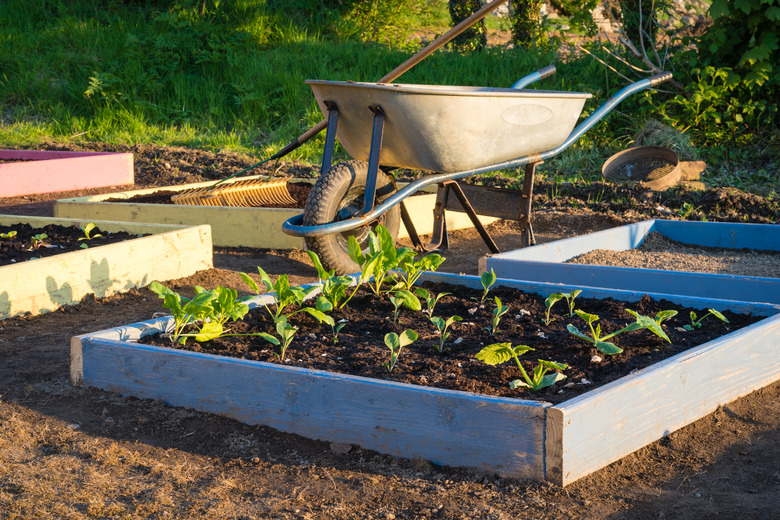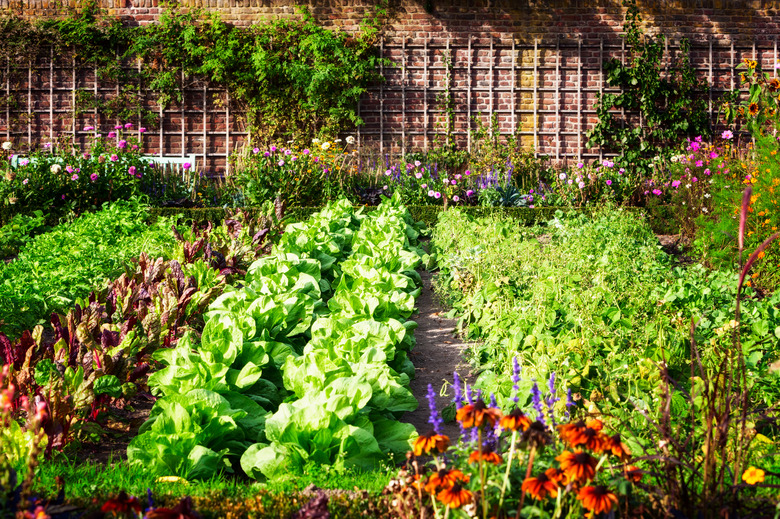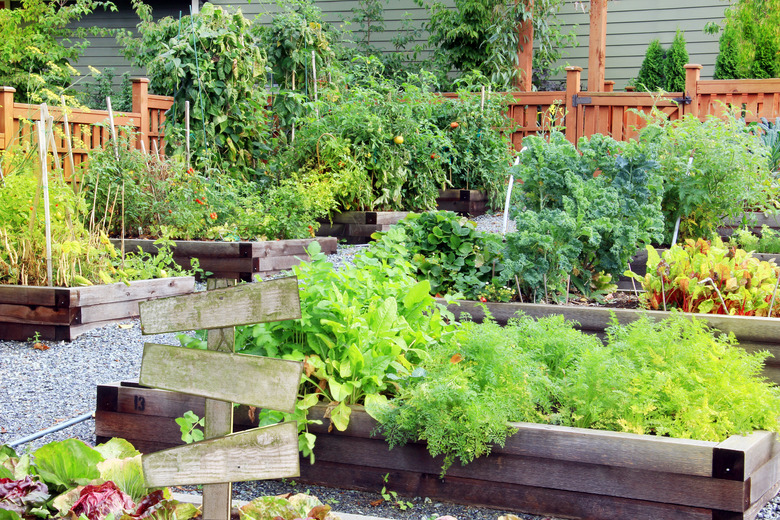8 Expert Tips For Your Vegetable Garden
We may receive a commission on purchases made from links.
If this year is not your first time having a vegetable garden, the timing may be right to ramp up your DIY gardening skills and give the produce section at your local grocery store a run for its money. A bountiful harvest of homegrown veggies can be the payoff for boosting your basic vegetable gardening knowledge to the next level with some expert tips that are easy to incorporate in your existing green-thumb repertoire. Although some of these tips involve actual hands-on planting and growing skills, others are important (but sometimes overlooked) planning steps that you can perform while sitting in your favorite chair inside your home.
1. Knowing When to Plant
1. Knowing When to Plant
One critical armchair project that impacts overall vegetable garden success and productivity is determining when to plant certain vegetables. Simply by putting pen to paper (or fingers to keyboard), the planning stages of a vegetable garden include not only making a list of what to plant but also knowing when to plant. For example, broccoli (Brassica oleracea var. botrytis) may be your favorite veggie, but if you're planning to grow it in summer with other vegetables, you'll be setting it up to fail. Broccoli is a cool-weather crop, which means that it needs the cool temperatures in spring and fall to prosper.
As a rule of thumb, you'll plant cool-season vegetables before the last spring frost date and warm-season veggies after the last spring frost date. As a little bonus, you'll be able to plant many cool-season crops again in late summer for a fall harvest. Light frosts actually enhance the flavor of some vegetables, such as Brussels sprouts (Brassica oleracea var. gemmifera), because this cold shock helps convert starches to sugar, which "sweetens" the taste of what can be a bitter-tasting veggie. Frost dates vary depending on location, but you can contact your local county cooperative extension service for this information as well as a list of when to plant different types of vegetables.
2. Soil Testing and Site Prep
2. Soil Testing and Site Prep
If you've only grown so-so vegetables in past years, don't give up without adding two steps to your vegetable garden routine. Your vegetable plants uptake nutrients from the soil through their roots, but the only way of knowing if your garden soil is nutrient-poor is to test it. Don't worry — you don't actually have to perform a soil test yourself because your local county cooperative extension service will do this for a nominal fee based on a soil sample you provide. This test not only analyzes the soil but also gives recommendations for the kind and amount of fertilizer needed to optimize production.
If you've only been randomly broadcasting fertilizer in your vegetable garden, you may be doing more harm than good. Excessive fertilization can be detrimental to plants by burning their roots or hindering vegetable production at the expense of promoting lush foliage. You can even overdo it if you're using too much organic fertilizer. Before you plant anything, prepare your vegetable garden beds by incorporating 25 to 30 percent organic matter, such as compost or well-aged animal manure, into the top 8 inches of soil.
3. Watering and Mulching
3. Watering and Mulching
Sufficient water is critical to the success of any vegetable garden. You'll need to make sure your veggie plants get 1 inch of water each week, so you'll need to provide this much water if rainfall doesn't supply it. Water not only keeps plants hydrated but it also moves nutrients from the soil up into the plants. When plants don't receive enough water, they're also deprived of nutrients, which hinders their growth as well as their production of veggies.
One inch of water each week may not sound like much, but for a 10 x 10-foot vegetable garden (100 square feet), this translates to 62 gallons. Rain may supply this entire amount during some weeks, but you'll have to pick up the slack if it doesn't. Using a simple rain gauge helps eliminate the guesswork. Applying several inches of mulch around your plants helps conserve moisture and reduces the supplemental watering you'll have to do.
4. Raised Beds and Container Gardening
4. Raised Beds and Container Gardening
If your garden soil is infertile, rocky or compacted, you may want to try growing vegetables in raised beds or containers. Elevated above the soil level, a raised bed or container vegetable garden provides good drainage and offers you the ability to choose a suitable growing mix to fill the beds and containers. You can even mix and match some ornamental flowers with salad greens in the same container, for example. Don't forget to observe plant spacing recommendations when you're growing in containers or raised beds; otherwise, plants can become overcrowded and unproductive as their roots compete with each other for nutrients.
Once you construct a raised bed and fill it with a growing mix for vegetable gardens, you'll want to avoid having to step into the raised bed to tend your plants and harvest the veggies. Walking inside the beds around your plants will compact the soil, making it more difficult for air and water to fill the pockets around the roots. Although raised beds can be any length, they're typically 4 feet wide to allow you to reach inside from both sides and 12 inches deep to accommodate healthy root systems. You may need to water your raised beds and container-grown veggies more often than in-ground plantings because of the sharp drainage, so keep an eye on this by looking for signs of wilting.
5. Vertical Gardening
5. Vertical Gardening
One way to optimize your vegetable garden yield is to maximize its growing area. Even if you have a small garden space, you can increase its growing area with a technique known as vertical gardening.
Some types of tomato plants (Lycopersicon esculentum, USDA zones 10 and 11) and other vegetables, such as zucchini (Cucurbita pepo var. cylindrica) and green beans (Phaseolus vulgaris), are bred as bush-type or dwarf/patio plants, but other types of these plants are vining crops. Although they don't naturally twine around structures (you'll have to tie them to a trellis or other structure), the stems grow longer than their bush or dwarf counterparts, which means that you'll be able to harvest more veggies from vining crops.
Other than using a trellis or trellis netting, you can also use stakes, tomato cages or obelisks to support vining crops. You can even plant vining veggies at the base of a chain-link fence or on either side of an arbor to soften the look of these structures.
6. Crop Rotation
6. Crop Rotation
Like many gardeners, you may have a designated vegetable garden spot in the backyard where you grow veggies year after year. Over time, however, this may actually lead to a decline in the garden's health and production. Why this is happening may be a mystery to you, particularly if you're diligent about the watering, fertilizing and spacing needs of your plants, but ratcheting up your veggie garden 101 skills to the 102 level includes practicing the important principle of crop rotation.
Plants that are in the same family share the same (or similar) vulnerabilities to certain pests or diseases. If you grow plants in the same family on the same site year after year, they become targets for disease organisms that overwinter in the soil or insect pests that pupate in the soil and emerge to feast on your crop. By growing different veggies in the same spot for at least three years in a row, you may be able to break the life cycles of diseases and insect pests.
It's important to note that it's not enough to grow a different plant on a site three years running; you'll need to grow a plant in a different plant family on the same site each year for three years. For example, tomatoes, peppers (Capsicum spp.) and eggplant (Solanum melongena var. esculentum) are members of the same plant family (Solanaceae), so growing tomatoes one year, peppers the next year and eggplant the third year on the same spot isn't an example of crop rotation. However, growing tomatoes (family Solanaceae) one year, green beans (family Fabaceae) the next year and zucchini (family Cucurbitaceae) the third year on the same spot is an example of crop rotation.
7. Plant Associations and Intercropping
7. Plant Associations and Intercropping
Although "companion planting" is the term that's used to describe the practice of grouping certain plant species together in the landscape or vegetable garden for their mutual benefit, this designation has strayed off target from its original meaning. Many so-called "companion plants" fulfill only anecdotal definitions without science-backed research to substantiate the claims. For multiple reasons, the actual science behind this concept is more precisely described in different terms, including "plant associations" and "intercropping."
Some substantiated plant associations benefits occur underground among plant root systems, such as nitrogen-fixing plant species that provide this nutrient to nearby plants or mycorrhizal nutrient transfers among roots of different plants. Perhaps the most common example of intercropping is the Native American "Three Sisters" method: planting corn (Zea mays) as support for climbing beans, which are planted around the base of the cornstalks and fix nitrogen in the soil, and squash around the outside of the beans to provide a living mulch to conserve water and inhibit weeds around all three plants.
A primary benefit claimed by supporters of the term "companion plants" is pest control; that is, certain plants repel insect pests, but many of these recommendations are merely anecdotal, lacking scientific research to support the claims. Plant researchers, however, support a stronger pest-management strategy: plant diversity. Diverse plantings attract beneficial insects, which kill pest insects. (Introducing ladybugs for the garden, for example, can eliminate aphids.) Boost your vegetable garden's diversity and therefore its enhanced plant associations by growing a variety of landscape plants, herbs and vegetables to attract pollinators and beneficial insects.
8. Extending the Growing Season
8. Extending the Growing Season
You can extend the growing season for your vegetable garden by getting an earlier start in spring and finishing later in the fall. Check the planting dates in your area for cool-season crops and get the transplants in the ground as early as possible. If there's an unexpected cold snap that extends your last expected frost date, protect the transplants by covering them with floating row covers. You can also do this in fall to extend your late-season harvest.
You can also use "low tunnels," which are simply constructed by spacing garden hoops approximately 3 feet apart over your veggies, covering the hoops with fabric or plastic and securing them to the ground with U-shaped landscape staples or bricks. Remove the protective covering when temperatures rise above the recommended guideline for a specific crop in your growing zone and replace the cover when temperatures threaten to dip below a safe threshold.


